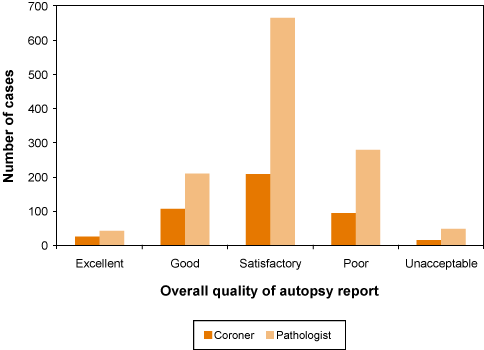|
The overall quality of the autopsy reports was presented in the previous section titled 'Overview of sample population'. To reiterate, the study sample displayed a normal distribution, with the majority of reports being marked by the advisors as satisfactory. There was roughly the same number of reports being marked good, as there was those marked poor; and similarly, there was roughly the same number of reports being marked excellent as there was those marked unacceptable.
Throughout this report, various aspects of the mortuary facilities have been correlated with certain components of the autopsy reports with this 'overall quality' score. These correlations have shown some interesting features - although it is important to note that by showing them, NCEPOD is not suggesting causality. To identify other (non-causal) associations related to the overall quality of the autopsy report, the following correlations were performed:
- quality of the autopsy report and position of the pathologist;
- quality of the autopsy report and mortuary workload.
Finally, the quality of the autopsy report was examined with respect to the profession of the advisors (coroners or pathologists), recognising that their professional backgrounds and experiences may have affected the way in which they mark cases.
Quality of autopsy report and the position of pathologist
Most coronial autopsies are performed and reported by consultant pathologists or
senior equivalents in medical schools and in forensic medicine practice. But all autopsy pathologists have to be trained and gain experience. With the reducing numbers of
consented autopsies nationally (see Introduction), the significance of the coronial autopsy
is progressively augmented for training. This study could not specifically identify how many autopsies had been utilised as part of training, but it did note when trainee pathologists had their names indicated on the reports (if they were the sole authors of the report).
Some excellent reports were those prepared by specialist registrars (SpR) and other trainee pathologists. In fact, when stratifying the overall quality of the autopsy report by position of pathologists, it was found that SpRs and paediatric pathologists produced better quality reports than consultant histopathologists and Home Office (forensic) pathologists (Table 23).
| Table 23: Overall quality of the autopsy report by specialty of pathologist |
| |
Excellent |
Good |
Satisfactory |
Poor |
Unacceptable |
| Histopathologist |
30 |
188 |
522 |
240 |
22 |
| Forensic pathologist |
9 |
21 |
61 |
20 |
11 |
| Neuropathologist |
1 |
2 |
5 |
0 |
0 |
| Paediatric pathologist |
2 |
1 |
2 |
0 |
0 |
| Associate specialist histopathologist |
0 |
2 |
6 |
2 |
0 |
| SpR (or other trainee) |
9 |
18 |
19 |
7 |
1 |
| Unknown |
16 |
83 |
258 |
104 |
29 |
| Total |
67 |
315 |
873 |
373 |
63 |
It is notable that forensic pathologists had the highest proportion of unacceptable autopsy reports compared with other specialties. This is worrying since, anecdotally, it is believed that they perform proportionately more coronial autopsies than hospital pathologists. However, the study did not document individual or specialty workloads and could not analyse this further. Conversely it is encouraging to see the high quality of trainees' reports. This supports the utility of coronial autopsies as, inter alia, a training procedure - and numerically the most important since consented adult autopsies are now uncommon. It also supports the suggestion that all pathologists start at a high quality level with regard to coronial autopsy practice, but then may slip in standards (see 'Overview and discussion section').
How many autopsies did pathologists perform?
One concern that has been indicated in previous NCEPOD reports, that may relate to poor quality of autopsy performance and reporting, is workloads for pathologists, with too many cases being done within limited time. The Shipman Inquiry made a similar point in the 3rd Report21. The study design and confidentiality of this study made it impossible to quantify this, so it was not known how many pathologists were undertaking autopsies and the numbers performed by each (and a one week sample would, of course, not be representative for the workloads of all autopsy active pathologists). With an estimation of the number of autopsy active pathologists in England and Wales at 700, and the known number of coronial autopsies performed in 2005 (114,600), the average is 164 cases per annum. There are no survey data available, but it is likely that the distribution of work is skewed, with a small number of pathologists doing a notably above average number of autopsies.
Quality of autopsy report and profession of advisor
The advisors for this study comprised both practicing coroners and pathologists. It was understood from the outset that the manner in which they assess autopsy reports may differ depending on their professional background and preconceived ideas concerning what constitutes a quality autopsy report. Recognising this, the meetings held to assess each case in the study comprised both coroners and pathologists, so that the possible differing views could be discussed between the advisors as a group.
As each case was assessed only once by one advisor, formal inter-rater variability was not assessed. However, many of the results were stratified by profession of advisor to identify if there were any general differences in the way coroners and pathologists assessed each case. This analysis identified that overall a higher number of cases scored by pathologists were marked as 'excellent' or 'good', (Figure 13). However, proportionately more cases were marked as 'excellent' or 'good' by coroners when calculated as a percentage of the total number of cases reviewed by coroners.
Figure 13: Overall quality of the autopsy report by profession of advisor

| 
